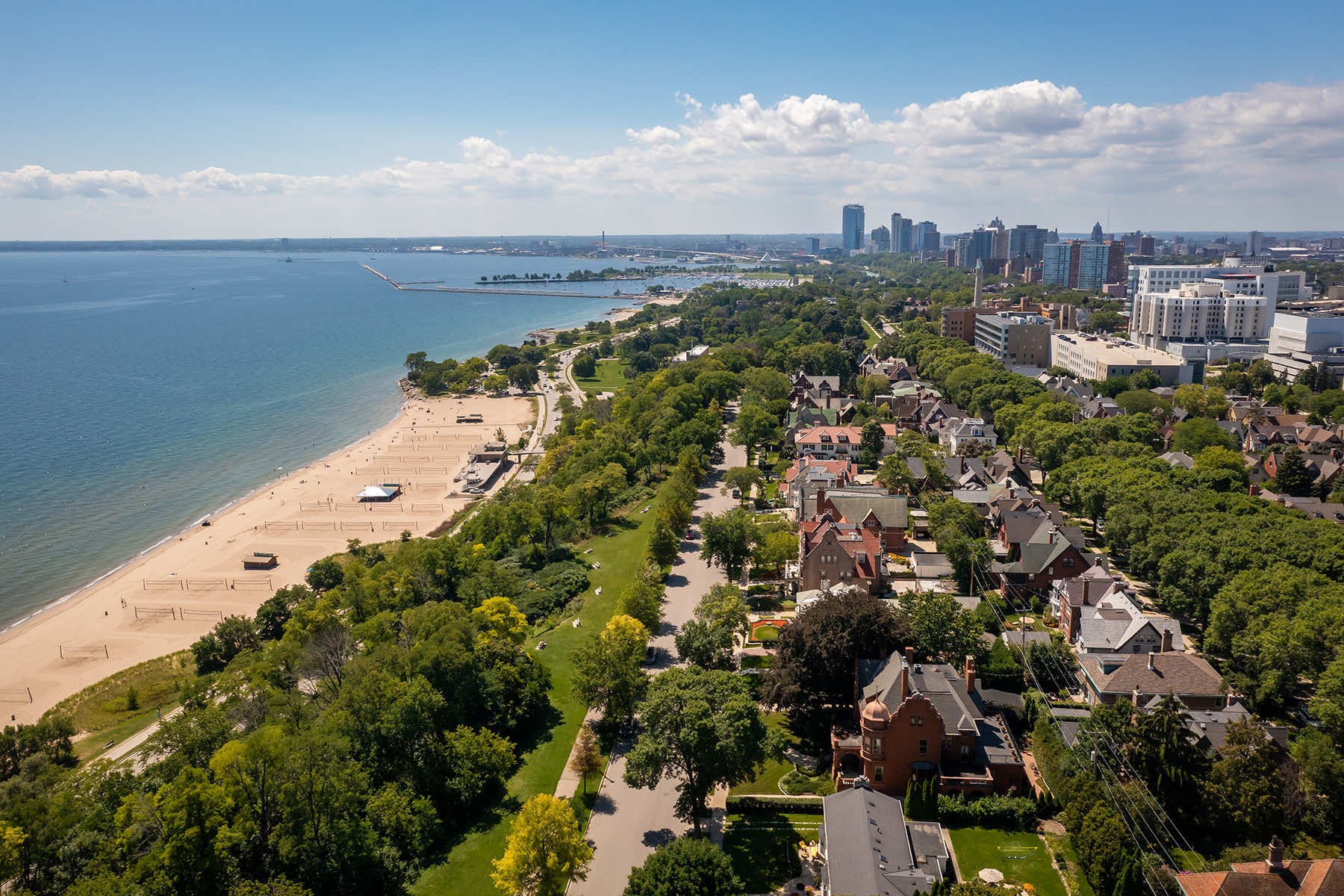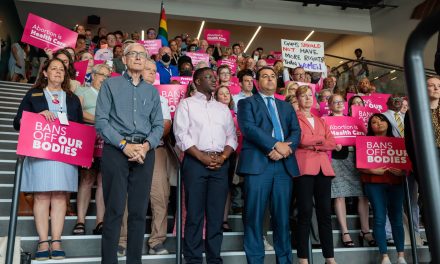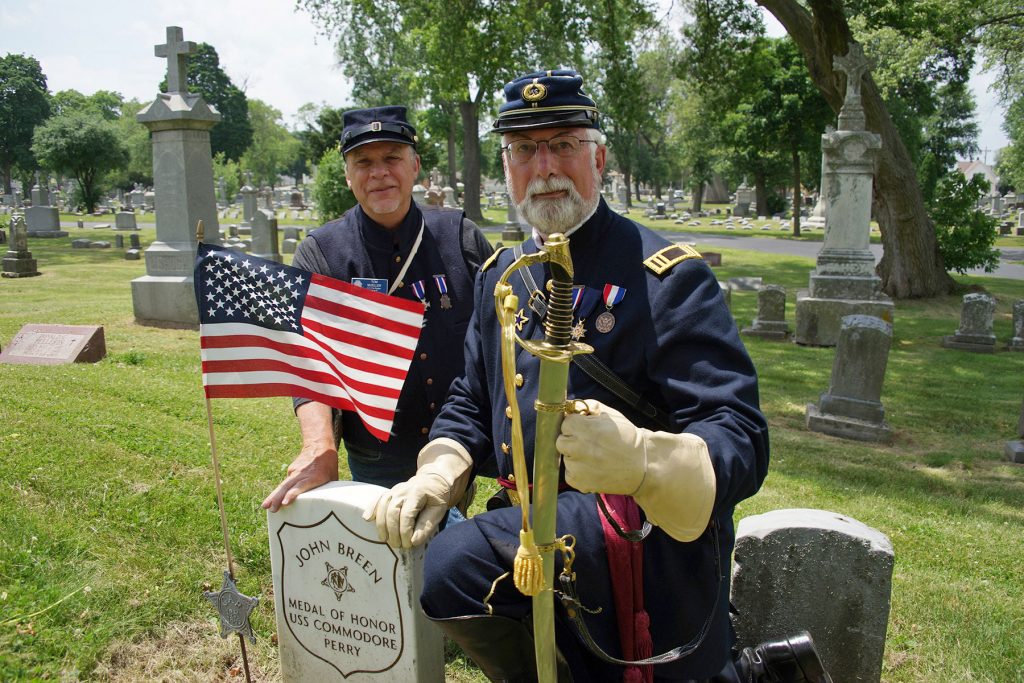
THE STATE OF MILWAUKEE: As a city, Milwaukee stands at the crossroads, where shifting policies, economic pressures, and community efforts are shaping the future of the city’s neighborhoods, businesses, and public services. This feature reviews one of those interconnected and evolving challenges affecting local residents today. Following Mayor Cavalier Johnson’s State of the City 2025 Address on March 3, this article is part of a series that explores everything from policing and public safety to healthcare, education, housing, business, infrastructure, and environmental changes. It also highlights the tension between progress and persistent disparities, focusing on policy decisions, economic realities, and how they impact daily life for Milwaukee residents.
Waves along the Lake Michigan shoreline have grown more unpredictable in recent years, sending water lapping farther inland than ever before.
At the same time, record-high temperatures and sudden downpours have tested the city’s parks and recreation areas in ways no one could have predicted a few decades ago. Milwaukee officials, along with nonprofit organizations and community groups, are working to address the effects of a changing climate on the city’s treasured public spaces.
LAKE MICHIGAN’S CHANGING SHORELINE
Lake Michigan stands as one of Milwaukee’s most defining natural features, drawing locals and visitors to its beaches, trails, and scenic overlooks. But water levels have fluctuated rapidly in recent years, sometimes rising to historic highs before receding again. Park managers say the changes lead to erosion and damage to pathways and beaches.
A few years ago, the city partnered with state officials to conduct shoreline stabilization projects. The initiatives often involve placing large rocks or installing barriers along areas most prone to erosion. While the fixes help in the short term, environmental experts warn that continuing changes in lake levels mean Milwaukee must look for long-term methods to protect its shoreline.
IMPACTS ON PUBLIC PARKS
Beyond the lakefront, Milwaukee County’s park system spans more than 150 parks and parkways, offering everything from hiking trails to community gathering spaces. Fluctuating weather patterns have left their mark on these green oases. Intense storms can flood low-lying areas, damaging playgrounds and picnic spots. Meanwhile, warmer winters and hotter summers force park officials to adapt maintenance schedules and replant certain areas with vegetation better suited to survive in variable climates.
Milwaukee County’s parks department has focused on planting more native species capable of withstanding temperature swings. These species often require less water, reducing strain on park budgets during drought-like conditions. Some local community groups have also joined forces with the parks department to organize volunteer days, where residents help clear out invasive plants that thrive in warmer temperatures and can choke out native foliage.
FLOODING AND STORMWATER MANAGEMENT
The city’s stormwater management system has come under increasing pressure from sudden bursts of heavy rain, a phenomenon that many climate scientists link to global warming. During these events, water can overwhelm storm drains, leading to flash floods in parks and nearby streets. To mitigate these risks, Milwaukee officials have experimented with green infrastructure solutions, such as rain gardens, permeable pavements, and bioswales.
In areas like the Menomonee River Valley, these measures have shown promise. Rain gardens and bioswales are designed to absorb runoff, slowing the flow of water and reducing erosion. The city’s Metropolitan Sewerage District (MSD) has also partnered with local businesses to install permeable surfaces in parking lots, allowing water to seep into the ground rather than pooling.
SHIFTS IN PARK USAGE
Climate shifts also influence how Milwaukee residents use public spaces. Warmer fall temperatures and milder springs mean people are taking advantage of park amenities for a longer portion of the year. However, extreme heat in summer or unseasonal downpours can deter visitors from spending time outdoors. Some community members have advocated for the installation of more shaded structures, water fountains, and cooling centers in high-traffic parks to help people cope with heat waves.
Other adaptations include adjusting programming schedules. Park-sponsored events such as outdoor concerts or festivals that once reliably took place in certain months might now need contingency plans for unexpected weather. Park officials report that volunteer groups have had to reschedule clean-up days more often due to sudden storms or heat advisories, highlighting the importance of flexibility in planning outdoor activities.
THE IMPORTANCE OF URBAN CANOPY
Trees provide shade, help manage stormwater, and absorb carbon dioxide. Milwaukee has placed an increased emphasis on expanding its tree canopy in parks and along streets. Yet, tree species historically common in the area may struggle as temperatures climb and precipitation becomes erratic. Experts are researching which varieties will fare best in the coming decades. Some of the species under consideration include oak, hickory, and tulip trees, which have shown better resilience in shifting climates.
Meanwhile, local nonprofits have been stepping up to help plant new saplings. These groups often organize volunteer-driven tree-planting events in parks or along parkways. City officials note that a well-managed urban forest not only makes neighborhoods more attractive but also plays a crucial role in mitigating the urban heat island effect, a concern when buildings and roads retain more heat than natural landscapes.
BEACH CLOSURES AND WATER QUALITY
Warmer water temperatures and more frequent rainstorms can trigger algae blooms or wash pollutants into Lake Michigan. As a result, Milwaukee’s beaches face elevated bacteria levels. The city and county monitor the water quality closely, posting advisories or closing beaches if conditions become unsafe for swimming.
In response, nonprofit organizations and educational institutions have launched initiatives focused on water quality testing and public awareness. Volunteers often collect samples from different points along the shoreline and test them for contaminants. The data, publicly available online, informs when officials should issue beach advisories. Advocates say that continued vigilance is vital to maintaining safe recreational spaces as climate conditions evolve.
GREEN DESIGN IN PARKS AND RECREATION CENTERS
Designing park facilities with sustainability in mind has become more common in Milwaukee. Some recreation centers now feature rooftop gardens, solar panels, and high-efficiency HVAC systems that reduce energy consumption and adapt well to temperature extremes. These features are not just environmentally beneficial but also act as educational tools. Park visitors can see how a structure powered by solar energy works or learn about local plant species that thrive in rooftop gardens.
Planners say that these design choices align with broader city strategies aimed at reducing carbon footprints and preparing for ongoing climate changes. Grants from state and federal programs often fund such capital improvements, though competition for these resources can be strong. Still, officials believe innovative green design is a worthwhile investment, as it lowers long-term operating costs and sets an example for private developers.
COLLABORATION ACROSS AGENCIES AND COMMUNITIES
Tackling climate-related challenges in public spaces involves coordinated efforts among multiple entities. The Milwaukee County Parks Department, the Milwaukee Metropolitan Sewerage District, and the city’s Department of Public Works (DWP) regularly collaborate on projects that can protect local ecosystems and infrastructure. Joint task forces often meet to plan initiatives that cross departmental lines, such as revamping a flood-prone park located near a major road.
Community organizations have become crucial partners in these endeavors. Block clubs and neighborhood associations frequently take the lead in cleaning local park areas or planting new trees. Environmental nonprofits provide educational programs for young residents, teaching them about the impacts of climate on their local parks and lakefront. By fostering a sense of shared responsibility, officials hope to secure broader support for public space adaptations.
ECONOMIC CONSIDERATIONS
Adapting public spaces to a changing climate is not without cost. Shoreline stabilization can run into the millions, while ongoing maintenance of green infrastructure adds recurring expenses to city and county budgets. Grants and philanthropic contributions help finance some of these efforts, but public funding remains essential. Milwaukee officials face the tough decision to allocate limited resources between park improvements, road repairs, or other pressing needs.
Local businesses also have a stake in maintaining vibrant parks and a picturesque lakefront, which attract tourists and contribute to the overall quality of life. Some companies have sponsored clean-up events or contributed to specific restoration projects. Others offer matching funds to encourage employees to volunteer or donate to environmental causes. Municipal leaders say such public-private partnerships can make a tangible difference, though they are no substitute for reliable public funding.
EDUCATION AND OUTREACH
Public awareness is key to any climate adaptation strategy. Many Milwaukeeans are already noticing how warmer lake waters and sporadic heavy rains affect their favorite beaches and parks, but officials believe more education is needed to encourage broad support for adaptation measures. Local schools integrate ecological and sustainability lessons into their curricula, sometimes bringing students to parks for hands-on learning experiences.
Nature centers scattered throughout the county also host workshops and guided tours that highlight climate challenges in Milwaukee’s public spaces. Visitors can observe erosion at the lakefront, identify invasive plant species, and learn about green infrastructure all in one trip. Organizers say these programs help residents form personal connections to local ecosystems, motivating them to support adaptation initiatives at both the neighborhood and policy levels.
EVOLVING RECREATION TRENDS
Changes in climate also influence what activities remain popular. For instance, cross-country skiing and ice skating may become less viable if winters continue to warm. Many residents, however, welcome the opportunity for longer fall or spring sports seasons, such as soccer, tennis or running clubs. Local park programs adjust their offerings accordingly, with flexible schedules that account for unpredictable weather.
Waterfront businesses that offer kayak or paddleboard rentals may experience extended seasons when lake temperatures stay mild longer. Yet more frequent storms pose additional safety considerations. Operators often need to watch weather forecasts closely to decide whether to suspend rentals on a given day, balancing economic opportunities against the risks of rough waters.
LOOKING AT THE BIGGER PICTURE
Predicting the pace and extent of climate change remains a challenge, but many of Milwaukee’s leaders see investing in public spaces as a crucial part of the city’s long-term strategy. From redesigning lakefront paths to installing more storm-resistant playground equipment, Milwaukee appears committed to keeping parks safe and welcoming for future generations. The city continues to explore new funding sources, design innovations, and collaborative strategies that can evolve alongside environmental conditions.
Residents are mixed in their reactions. Some applaud the city and county for taking steps to protect community green spaces, while others worry about potential tax increases to fund these projects. As climate shifts bring unpredictable costs, officials say candid conversations about priorities and funding will be essential.
While climate change poses many challenges, it also creates opportunities for Milwaukee to think creatively about its public spaces. Initiatives that might have seemed niche or overly ambitious 20 years ago, like constructing bioswales or building boardwalks for flooded wetland trails, are now part of mainstream discussions about how to preserve Milwaukee’s identity as a city that values nature and recreation.
For park planners and city officials, the adaptability of Milwaukee’s public spaces represents both an immediate necessity and a long-term goal. Their hope is that by making calculated, evidence-based decisions now, the city can ensure that its lakefront and parks remain resilient to the changing climate, all while continuing to serve as gathering places for neighbors, families, and visitors.
© Photo
James Meyer (via Shutterstock)















